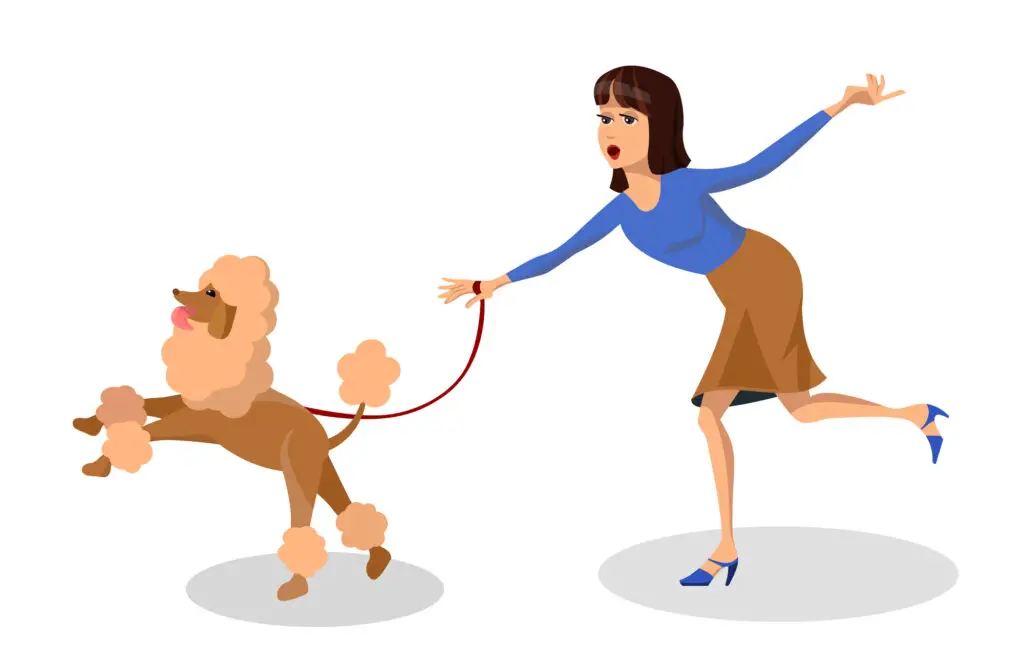As a proud poodle owner, I understand the struggle of dealing with a poodle that constantly pulls on the leash during walks. It can be frustrating and make the walk less enjoyable for both you and your poodle.
However, with the right training techniques, you can teach your poodle to walk politely on a leash using a headcollar. In this article, I will guide you through the process of training your poodle to stop pulling on the leash and introduce you to the benefits of using a headcollar.

What Will You Learn? 👇
Why Do Poodles Pull on the Leash?
Before we dive into the training process, it’s important to understand why poodles pull on the leash in the first place. Poodles are energetic and curious dogs, and pulling on the leash may be their way of exploring their surroundings or trying to reach something that caught their attention. They may also pull because they haven’t been properly trained to walk calmly on a leash. Whatever the reason, it’s important to address this behavior to ensure a pleasant walking experience for both you and your poodle.

Introducing the Headcollar
A headcollar is a training tool that can be used to gently and effectively control your poodle’s pulling behavior. It consists of a collar that fits around your poodle’s neck and another strap that goes over their muzzle, similar to a horse’s halter. The headcollar works by providing you with more control over your poodle’s head and direction, making it easier to redirect their attention and prevent pulling. Here’s how to introduce the headcollar to your poodle:

Read our Smart Poodles - Smart Tricks eBook for only $2.99
Dive into a treasure trove of engaging tricks and tips designed specifically for your poodle!
- Familiarization: Allow your poodle to sniff and investigate the headcollar before putting it on. Offer treats and praise to create positive associations with the headcollar.
- Positive Reinforcement: Gradually introduce the headcollar by attaching it to your poodle’s collar or harness during short training sessions. Reward your poodle with treats and praise for wearing the headcollar calmly.
- Desensitization: Gradually increase the duration of headcollar wear, making sure your poodle remains comfortable. Use treats and positive reinforcement to create a positive association with the headcollar.
- Practice Indoors: Start practicing walking with the headcollar indoors, where there are fewer distractions. Use treats and gentle leash guidance to encourage your poodle to walk beside you without pulling.
Training Your Poodle to Walk Politely on a Leash
Now that your poodle is comfortable with the headcollar, it’s time to start training them to walk politely on a leash. Remember to be patient and consistent throughout the training process. Here’s a step-by-step guide to help you:
- Proper Fit: Ensure the headcollar is properly fitted, with the strap around your poodle’s muzzle loose enough to allow them to pant and drink water comfortably.
- Positive Associations: Before each training session, create positive associations with the headcollar by offering treats and praise. This will help your poodle associate the headcollar with positive experiences.
- Start Slow: Begin training in a quiet and familiar environment, such as your backyard or a quiet park. This will help minimize distractions and allow your poodle to focus on the training.
- Use Gentle Guidance: Hold the leash with a relaxed grip and use gentle leash pressure to guide your poodle’s direction. Avoid yanking or pulling on the leash, as this may cause discomfort or confusion.
- Reward Good Behavior: Praise and reward your poodle with treats for walking calmly beside you without pulling. This positive reinforcement will encourage them to continue behaving in the desired manner.
- Redirect Attention: If your poodle starts to pull, gently redirect their attention back to you by changing direction or using a verbal cue, such as “heel” or “let’s go.” Reward them when they respond by walking beside you without pulling.
- Increase Distractions: As your poodle becomes more comfortable walking with the headcollar, gradually increase the level of distractions during your training sessions. This will help them generalize their polite walking behavior in different environments.
- Consistency is Key: Practice walking with the headcollar regularly to reinforce the desired behavior. Consistency and repetition will help your poodle understand what is expected of them.
Tips for Successful Training
- Short Sessions: Keep training sessions short and frequent, focusing on quality rather than quantity. A few minutes of focused training each day will yield better results than one long session.
- Positive Reinforcement: Use treats, praise, and play as rewards for good behavior. Positive reinforcement will motivate your poodle to repeat the desired behavior.
- Be Patient: Remember that training takes time and every poodle learns at their own pace. Stay patient and understanding throughout the training process.
How long does it take to train a poodle to stop pulling on the leash?
The time it takes to train your poodle to stop pulling on the leash can vary depending on the individual dog and consistency of training. It may take a few weeks or even a couple of months to see significant improvement. Patience and consistency are key!
Can I use a headcollar for all types of poodles?
Yes, headcollars can be used for all types of poodles, regardless of their size or age. Just make sure to choose the appropriate size headcollar that fits your poodle comfortably.
Are headcollars safe for poodles?
When used correctly and fitted properly, headcollars are safe for poodles. However, it’s important to follow the manufacturer’s instructions and consult with a professional trainer if you have any concerns.
Can I still use a regular collar or harness for my poodle?
Yes, you can still use a regular collar or harness alongside the headcollar. The headcollar is an additional tool to help with leash training, but it doesn’t replace the need for a collar or harness for identification and attaching the leash.
Join the Training Journey!
I hope this guide helps you train your poodle to stop pulling on the leash using a headcollar. Remember, consistency, patience, and positive reinforcement are key to success. If you have any questions or want to share your training experiences, leave a comment below. Let’s create a community of poodle owners who support and learn from each other. Happy training!
Comment below and share your experiences in training your poodle to stop pulling on the leash with a headcollar. We’d love to hear from you!
Marko is the founder and author at PoodleHQ, where he blends profound expertise with formal training in Animal Behavior and Canine Genetics. With multiple generations of poodles under his care, he’s a breed connoisseur, honored with the Canine Care Excellence Award and lauded by the International Pet Enthusiasts Association.

